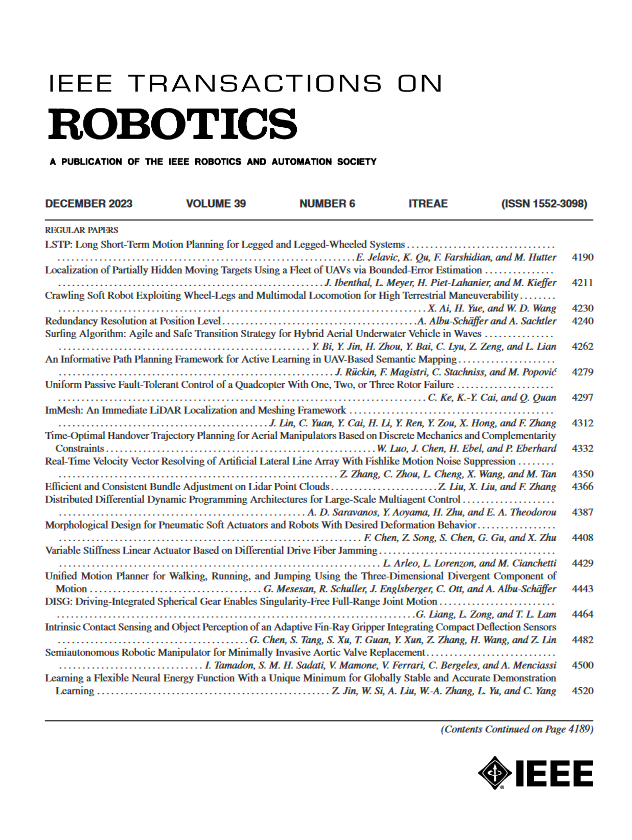具有模块化轴向磁化的磁性连续体机器人:设计、建模、优化和控制
IF 10.5
1区 计算机科学
Q1 ROBOTICS
引用次数: 0
摘要
磁连续体机器人(mcr)由于其易于小型化而无需复杂传动结构的固有优点而受到广泛欢迎。从最初的嵌入式磁体设计到当前具有特定磁化轮廓配置(mpc)的设计,mcr的发展显著提高了它们的灵活性。虽然已经取得了很大的进展,但基于定量指标的不同mpc变形能力评估,可以帮助设计具有增强机器人变形能力的mpc,这在以前还没有得到解决。在这里,我们使用“变形能力”来描述MCR在外部磁场下形成不同整体形状时的体挠度能力。因此,在本文中,我们提出了设计和控制模块化轴向磁化段组成的MCR的方法。为了指导机器人MPC的设计,我们首次引入了一种基于定量指标的评价策略来分析和优化机器人的变形能力。此外,开发了一种基于神经网络控制器的控制框架,赋予机器人两种控制模式:机器人尖端位置和方向($M_{1}$)和整体形状($M_{2}$)。通过仿真和实验平台验证了所学习控制器在计算时间和精度方面的优异性能。实验结果表明,模式$M_{1}$的最佳闭环控制性能指标为0.254 mm和0.626$^\circ$,模式$M_{2}$的最佳闭环控制性能指标为1.564 mm和0.086$^\circ$。本文章由计算机程序翻译,如有差异,请以英文原文为准。
Magnetic Continuum Robot With Modular Axial Magnetization: Design, Modeling, Optimization, and Control
Magnetic continuum robots (MCRs) have become popular owing to their inherent advantages of easy miniaturization without requiring complicated transmission structures. The evolution of MCRs, from initial designs with one embedded magnet to current designs with specific magnetization profile configurations (MPCs), has significantly enhanced their dexterity. While much progress has been achieved, the quantitative index-based evaluation of deformability for different MPCs, which can assist in designing MPCs with enhanced robot deformability, has not been addressed before. Here, we use “deformability” to describe the capability for body deflection when an MCR forms different global shapes under an external magnetic field. Therefore, in this article, we propose methodologies to design and control an MCR composed of modular axially magnetized segments. To guide robot MPC design, for the first time, we introduce a quantitative index-based evaluation strategy to analyze and optimize robot deformability. In addition, a control framework with neural network-based controllers is developed to endow the robot with two control modes: the robot tip position and orientation ($M_{1}$ $M_{2}$ $^\circ$ $M_{1}$ $^\circ$ $M_{2}$
求助全文
通过发布文献求助,成功后即可免费获取论文全文。
去求助
来源期刊

IEEE Transactions on Robotics
工程技术-机器人学
CiteScore
14.90
自引率
5.10%
发文量
259
审稿时长
6.0 months
期刊介绍:
The IEEE Transactions on Robotics (T-RO) is dedicated to publishing fundamental papers covering all facets of robotics, drawing on interdisciplinary approaches from computer science, control systems, electrical engineering, mathematics, mechanical engineering, and beyond. From industrial applications to service and personal assistants, surgical operations to space, underwater, and remote exploration, robots and intelligent machines play pivotal roles across various domains, including entertainment, safety, search and rescue, military applications, agriculture, and intelligent vehicles.
Special emphasis is placed on intelligent machines and systems designed for unstructured environments, where a significant portion of the environment remains unknown and beyond direct sensing or control.
 求助内容:
求助内容: 应助结果提醒方式:
应助结果提醒方式:


